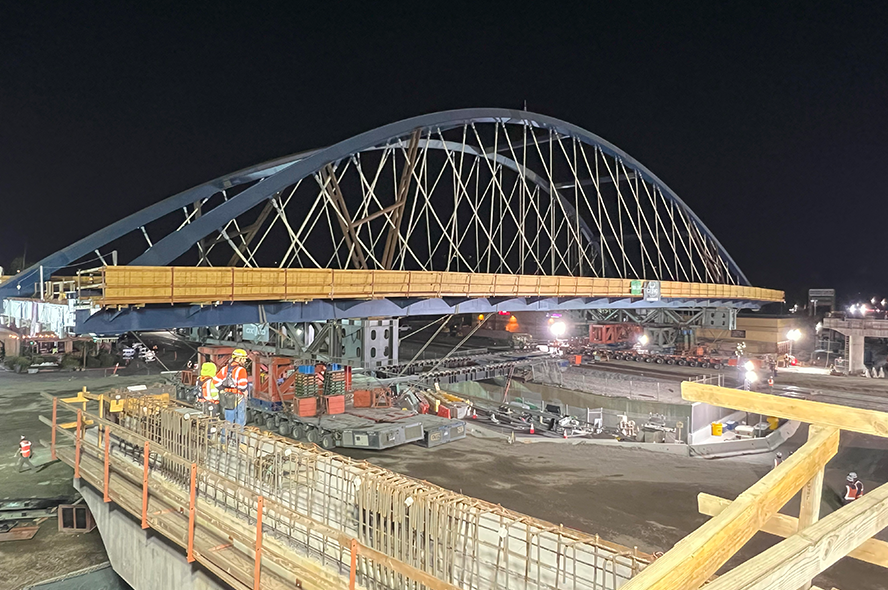Tufts alum designs an innovative bridge

A Tufts School of Engineering education helps prepare students for career success. Double Jumbo Eric Pheifer, E08, EG10, now applies the skills he learned at Tufts in his work as a bridge designer and principal at Biggs Cardosa Associates Inc. He recently designed a network tied-arch bridge that was moved into place successfully in Corona, California. Read on to learn more about his experience and how his time at Tufts paved the way for his current achievements.
What is a tied-arch bridge?
A traditional arch bridge resists thrust in the bridge foundations. A tied-arch bridge has a structural tension member along the bottom to resist those forces.
What is unique about your bridge design?
This bridge type is a network tied-arch bridge. The cable hangers are diagonal and cross each other (creating a “network”) rather than vertical hangers. The result is a very structurally efficient arch rib that allows steel quantities to be reduced compared to vertical hangers. Steel is very expensive, so this efficiency was critical in ensuring the structure was economical. This is the first vehicular steel network tied-arch bridge in California.
Is this your first time designing a bridge? What made this particular project in Corona, California stand out?
I have designed a number of bridges ranging in material and function, from prefabricated pedestrian truss bridges to movable railroad bridges. The design process for this project was especially unique since this is a relatively new bridge type in the United States.
How will this bridge be used?
The bridge will carry four lanes of vehicular traffic and includes a pedestrian sidewalk.
What was the most rewarding part of this project for you?
I love projects that involve grade separations. It’s a puzzle to figure out how to separate railroad traffic from vehicles and pedestrians, and to come up with a concept that minimizes impacts to the public, utilities, and more. I did a lot of brainstorming prior to the release of the request for proposals, and thought using this bridge type and building it in a staging area and then moving it with self-propelled modular transports (SPMTs) would address a number of the project’s challenges.
It was a highlight of my career and life to see this bridge get erected and moved with SPMTs. Grade separation projects are also inherently rewarding since we’ve improved safety by eliminating potential train and vehicle/pedestrian collisions, improved access for emergency responders, and generally improved mobility for the community.
How did your Tufts education impact where you are today?
I received my bachelor’s degree [in civil engineering] in 2008 and my master’s degree [in civil and environmental engineering, with a focus on structural engineering] in 2010, both from Tufts. My classes and graduate research exposed me to a variety of structure types and innovative design and analysis methodologies. That foundation allows me to think outside the box and deliver innovative solutions for our clients.
What advice would you give someone studying engineering right now?
Find real-life engineering challenges – either through your own independent research and/or internships – and think about how your education will help you solve those challenges. Getting a high score on a test is rewarding, but it’s even more rewarding if you can visualize how you’ll use those skills in your upcoming career to change the world.
Department:
Civil and Environmental Engineering